On this page
Operating your wood heater
Smoke from wood heaters has the potential to cause serious health and environmental impacts if not operated satisfactorily or if incorrect materials are burnt.
Reduce smoke emissions from your wood heater by:
- Checking that your wood heater, whether it is new or existing, complies with relevant Australian standards;
- Only using well-seasoned firewood – timber that has reduced moisture content from being stacked and properly stored, undercover, for an extended period to allow the moisture to evaporate. Seasoned wood burns with greater heat than “unseasoned” or “green” wood and produces less smoke. The Firewood Association of Australia recommends buying wood in the summer months and stacking under a roof cover with open sides;
- Always burning with a flame;
- Burning the fire on high for 20 minutes after adding wood;
- Always keeping the air vents open enough to keep some kind of flame;
- Not shutting your fire right down when you go to bed; and
- Never letting the fire smoulder.
Winter is coming
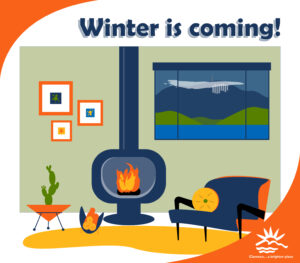
Winter means wood heaters and burn-offs, it’s important to keep smoke emissions to a minimum for the sake of your neighbours and the environment.
Smoke from wood heaters is a major cause of air pollution and can negatively affect your health.
By improving how we use our wood heaters, harmful smoke pollution can be drastically reduced.
Using well-seasoned firewood and having a wood heater that is certified and regularly maintained makes a big difference.
For up-to-date information on using wood heaters go to the EPA Tasmania website here
Wood heater tips
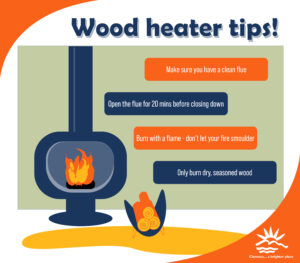
If you use a wood heater to keep warm this winter, you can reduce smoke pollution and help your neighbours breathe easier.
Simply follow these steps to burn your wood heater brighter, warmer, and cleaner, this winter.
- Make sure you have a clean flue
- Open the flue for 20 minutes before closing down
- Burn with a flame and don’t let your fire smoulder
- Only burn dry, seasoned wood.
For more Information on improving your wood heater use go to the EPA Tasmania website here
How do you know if the wood heater you buy complies with the regulations?
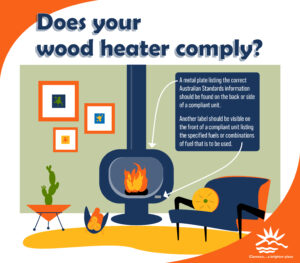
Under the Tasmanian Government Environmental Management and Pollution Control (Smoke) Regulations 2019 all heaters made or sold in Tasmania, or imported into the State, must comply with the current Australian Standards for heater emissions and efficiency.
This also applies to all second-hand units sold in Tasmania.
If you are buying a wood heater, make sure it has a compliance plate showing that it meets Australian Standards AS/NZS 4012-2014 and AS/NZS 4013- 2014.
The modification of wood heaters in any way that may increase smoke emissions is prohibited.
Please check EPA Tasmania site to see more information.
For information on smoke emissions rules go to the EPA Tasmania website here
Which chimney do you prefer?
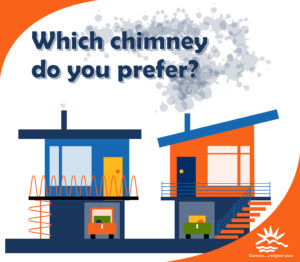
How can you tell if your wood heater or fireplace is operating within the regulations.
Well, it’s easy, just check your wood heater or fireplace chimney for smoke visibility.
A well-maintained heater or fireplace should produce little visible smoke when a fire is burning well.
If the fire smokes for more than 10 minutes at any stage, there is a problem with the fuel, the operating method or both.
For information on smoke emissions rules go to the EPA Tasmania website here
Is smoke in your neighbourhood causing a nuisance?
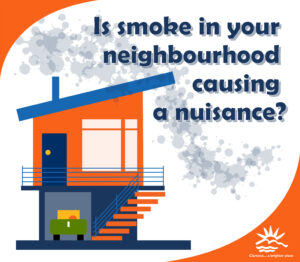 Often your neighbours will not realise their fire is affecting you,
Often your neighbours will not realise their fire is affecting you,
so it’s best to discuss the problem with them and try to find a solution.
However, wood-smoke can easily become an environmental nuisance.
An environmental nuisance is any emission of a pollutant that may unreasonably interfere with a person’s enjoyment of their environment.
If you cannot reach an agreement with your neighbour after talking to them, you can contact an environmental health officer at Clarence City Council for advice.
For more information go to the EPA website
Backyard burning
Current state regulations do allow burning on properties of any size however please note the following applies for a land area less than 2000m² as per the Smoke Regulations:
- The backyard burning is done in accordance with any relevant fire permit, Environment Protection Notice (EPN) or Council bylaw; and
- All practical means are taken to prevent or minimize air pollution (considering weather conditions, nearby neighbours and only burning dry vegetation).
Before any burning is undertaken in your backyard, please check if there are fire bans, alerts or permit requirements with Tasmania Fire Service. Check their website at www.fire.tas.gov.au or call 03 6173 2740.
In addition, section 53 of the Environmental Management and Pollution Control Act 1994 has a requirement that when undertaking backyard burning a person should not cause an ‘environmental nuisance’. This includes smoke emissions.
Even if you are acting in accordance with the Smoke Regulations, your burning activities may still have the potential to create an environmental nuisance. It is your responsibility to do everything you can to minimise the smoke you create.
Please note, burning should only be used as a last resort.
Council provides services to properties to help minimise the need for backyard burning. Extensive garbage, recycling and green waste collection services are available to most properties in Clarence.
Private waste removal services are also available to help dispose of excessive garden waste as well as mobile chippers that can chip garden waste into mulch.
If you must burn, help avoid a nuisance to neighbouring properties by:
- Burning with a clear flame and don’t let the fire smoulder and smoke.
- Consider the wind direction and wind speed to see where any smoke might blow and if it is safe to light the fire.
- Check the weather conditions at http://www.bom.gov.au/tas/forecasts/hobart.shtml for any current weather warnings.
- Assess the length of time that the vegetation or vegetative waste being burnt is likely to burn.
- Consider the proximity of any nearby residents.
- Ensure you only burn clean/untreated and uncontaminated wood, dry vegetation and dry vegetative waste.
- Ensure the vegetation or vegetative waste is suitable for disposal by burning.
Under the Smoke Regulations you cannot burn:
- asbestos
- tyres
- coated wire
- paint containers and residues
- chemical containers and residues
- timber treated with copper chrome arsenate (CCA), pentachlorophenol (PCP), oil or any other chemical
- rubber
- painted wood
- plastic
- oil
- household waste
- linen
- foam rubber
- polystyrene
Penalties may apply should you not adhere to this as a guide.
Barbecues and other small fires used solely for heating or cooking are not considered to be backyard burning. However, if you use them to get rid of vegetative or other types of waste, then the above backyard burning restrictions do apply. The requirements for wood-fired heating and cooking can be found at EPA Tasmania’s website at https://epa.tas.gov.au/epa/air/wood-fired-heating-and-cooking.
More information
- For more information on wood moisture levels visit the Firewood Association of Australia website.
- For more information on effective wood heater usage and on a review of existing regulations visit the EPA website.
- The Tasmanian Department of Health and Human Services provides more information on outdoor smoke and your health and air quality real time data from sites around Tasmania.
- For more information on backyard burning, go to State Government’s Environmental Protection Authority’s website at https://epa.tas.gov.au/epa/air/backyard-burning.